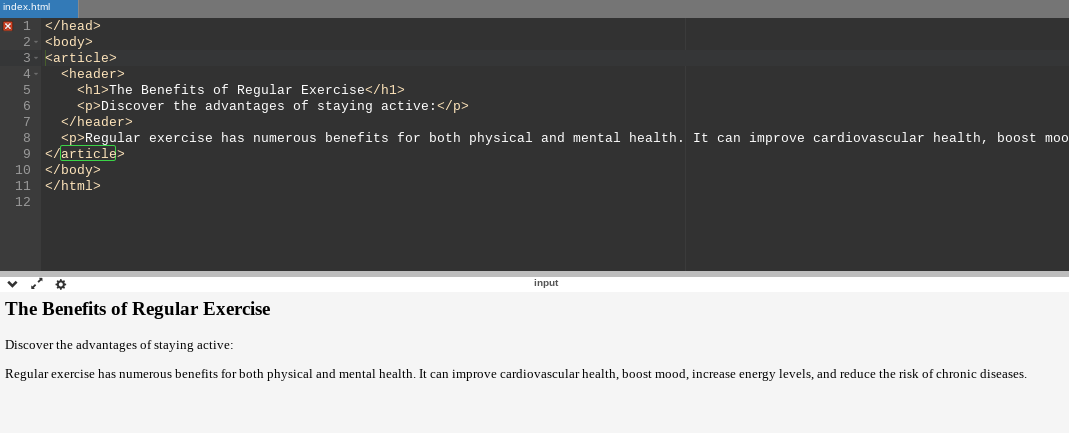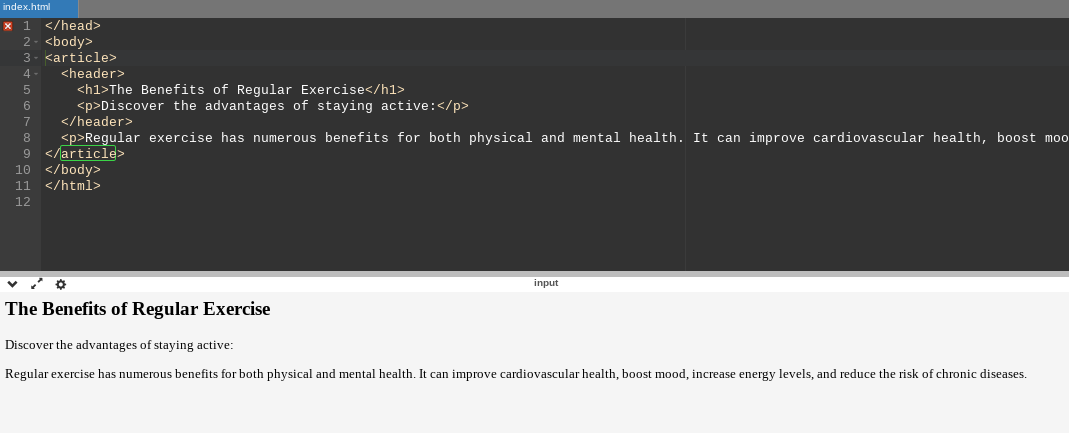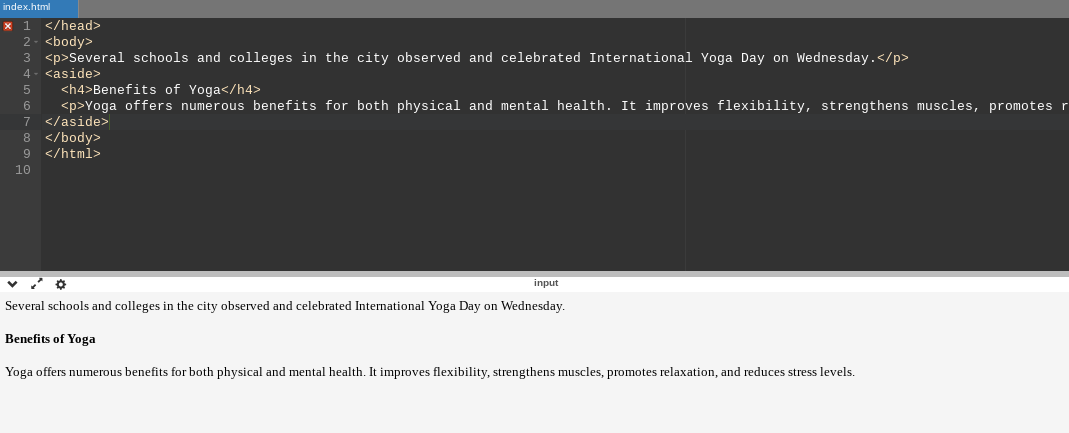Working professionals
Fresh graduates
- Study abroad
- Offline centres
More
2. HTML Basics
3. HTML Syntax
9. HTML Head
10. HTML Title
11. HTML Styles
12. HTML Paragraphs
13. HTML Symbols
14. HTML Emojis
15. HTML Formatting
16. HTML Entities
17. HTML Audio
18. HTML Images
19. HTML Lists
20. HTML Links
21. SVG in HTML
22. HTML Forms
23. HTML Video
24. HTML Canvas
25. Adjacency Lists
26. HTML Input Types
27. HTML Tables
31. HTML Layout
33. HTML Div
37. HTML Iframes
40. HTML Code
41. HTML Colors
42. HTML CSS
43. HTML Editors
44. HTML Examples
45. Class in HTML
46. HTML Exercises
47. HTML ID
49. HTML Table Style
50. HTML Script
HTML Semantic Elements
A developer’s work is not confined to designing a website's layout and providing structure. As a developer, you may have worked tirelessly to decide on the page structure, font size, style, color, placement of the graphics, and so on. But how do you define your page’s hierarchy?
If you have opted for an HTML course, you must have learned about the conventional HTML elements such as <span> and <div>, which are generic containers that help to style and structure a website’s content. However, if we do not insert semantic meaning, it becomes difficult for accessibility tools and search engines to understand the purpose the different parts of your webpage are supposed to serve.
Semantic elements in HTML are important aspects of web development that help convey the meaning and define the purpose of your website’s content. This kind of specification imparts information not only to viewers but also to machines that determine the webpage's ranking in Google SERPs.
Some such examples of semantic tags in HTML are <header>, <article>, <footer>, <main>, <aside>, etc. In this tutorial, I will explore what is semantic HTML and guide you through some of these semantic elements in action. Let's dive in!
Why Do We Use Semantic Elements in HTML?
Semantic elements in HTML help improve a website’s consistency across the internet. Before I delve deeper into the discussion, let us first glance through the benefits of using semantic elements in HTML.
Easy Accessibility
The use of HTML semantics helps improve website accessibility. This is beneficial for mobile applications as it requires less memory than non-semantic HTML. Although this may not show much variation for small applications, the difference is very prominent for larger websites.
Semantic elements help in better interpretation of the codes and improve the responsiveness of the websites.
The primary function that semantic elements in HTML perform is that they define the different sections of a website very clearly. As a result, consistency is maintained throughout the web page, and the audience is able to enjoy a smooth and seamless experience.
Better Optimization
Search Engine Optimization (SEO) defines the rank of a website on the SERPs. Semantics help improve the rank of a website by making the contents easily identifiable to search engines.
The use of semantic elements in HTML helps browsers interpret the codes better and identify the structure of the website for better optimization.
What are the Different Semantic Elements in HTML?
Many web pages contain HTML codes such as <div id=”nav”>, <div class=”header”>, and <div id=”footer”> to denote navigation, header, and footer sections.
The <div> part is non-semantic. Therefore, in order to ensure the specificity of certain <div> elements, developers need to add an id attribute.
There are many semantic elements in HTML5 that can help developers define their web pages better. I have listed some of them below:
- <article>
- <aside>
- <details>
- <figcaption>
- <figure>
- <footer>
- <header>
- <main>
- <mark>
- <nav>
- <section>
- <summary>
- <time>
In the next part of the tutorial, I will provide a few examples that will help clarify the HTML 5 semantic tags.
HTML Semantics Use Cases
These use cases of HTML semantics will help you have a better idea about the use of semantic elements in HTML.
<section> Element in HTML
When a write-up is divided into sections, it ensures ease of comprehension and readability. This is defined with the help of the <section> element in HTML.
A web page can be split into sections for writing chapters, introductions, contact information, etc.
Let us understand the use of the <section> with the help of this example. Suppose we are trying to create a webpage that will have two sections, the code will be:
Code:
</head>
<body>
<header>
<h1>Welcome to My Website</h1>
</header>
<section>
<h2>Section One</h2>
<p>This is the content of the first section.</p>
</section>
<section>
<h2>Section Two</h2>
<p>This is the content of the second section.</p>
</section>
<footer>
<!-- Footer content goes here -->
</footer>
</body>
</html>
Compilation:

The screenshot below shows the outcome that this code will generate.
<article> Element in HTML
In HTML, the <article> element is used to denote a piece of content that is self-contained and can be told apart from the rest of the web page. This element is ideally used for content like news articles, blog posts, forum posts, or any such content that can stand alone.
Here is an example to show how to use the <article> element in HTML:
Code:
<article>
<h2>Scientists Discover New Species of Butterfly</h2>
<p>A team of researchers has identified a previously unknown species of butterfly in the Amazon rainforest...</p>
<footer>
<p>Published on February 28, 2024 by National Geographic</p>
</footer>
</article>
This code will generate the following outcome:

<header> Element in HTML
Every write-up has headings at the top of the webpage or within sections. HTML has a <header> element that is used to define the navigational or introductory content at the top of a webpage.
The <header> section contains the headings, authorship information, logos, navigation menus, search bars, and other elements that are important for the overall structuring and navigation of the webpage.
Let us understand how to create a header using HTML5 semantic tag header with an example. The code is as follows:
Code:
<article>
<header>
<h1>The Benefits of Regular Exercise</h1>
<p>Discover the advantages of staying active:</p>
</header>
<p>Regular exercise has numerous benefits for both physical and mental health. It can improve cardiovascular health, boost mood, increase energy levels, and reduce the risk of chronic diseases.</p>
</article>
Compilation:

In this semantic element in HTML, the <article> element contains information about the advantages of exercising regularly. The <header> element has the <h1> tag that denotes the main heading of the topic. Next, the <p> element provides readers with an introduction so they know what to expect from the article.
The main body of the article starts from the next <p>.
It is important to note that an HTML document can contain multiple header elements. However, header elements cannot be placed within the address, footer, or another header element.
<footer> Element in HTML
As the term itself suggests, the <footer> semantic element in HTML is used to define the footer for a section or an entire document. This semantic element encompasses important information like information about authorship, contact information, copyright information, or sitemap information.
The <footer> semantic element in HTML may also contain information about the related documents or direct users back to top links.
You can scroll back to the example we have used in the <article> element section to understand how the <footer> HTML element works.
<nav> Element in HTML
The <nav> semantic element in HTML is used to define a set of navigation links. It contains the list of links, menus, and other navigation-related content that is present on a webpage.
<aside> Element in HTML
Do you remember how our school textbooks had a small box on one side of the page that read “Fun Facts” or “Did You Know?” This is a classic example of the use of the <aside> element in HTML.
The <aside> semantic element in HTML defines some content that is placed in a sidebar. The content is, however, indirectly related to the content that the webpage is dealing with.
Let us understand this with an example.
Code:
<p>Several schools and colleges in the city observed and celebrated International Yoga Day on Wednesday.</p>
<aside>
<h4>Benefits of Yoga</h4>
<p>Yoga offers numerous benefits for both physical and mental health. It improves flexibility, strengthens muscles, promotes relaxation, and reduces stress levels.</p>
</aside>
The result for this code will be displayed thus:

Final Words
I hope this tutorial has provided you with a lot of information on the new semantic elements in HTML5. Developers can use these HTML 5 elements to provide specific information about the various parts that make up a webpage.
If you are looking forward to learning more about HTML, you can check through the courses offered by upGrad. These courses will help you learn the features connected to HTML and give you a competitive edge in this fast-pacing digital age.
Learn, apply your knowledge in projects, and excel in the realm of website development!
Frequently Asked Questions
1. What is the semantic element of language?
It is an element that helps to clearly denote what kind of content an element contains.
2. How many semantic tags are there?
There are several semantic tags in HTML like
3. What are semantic documents using HTML?
Semantic documents using HTML are web pages that use HTML elements to accurately convey the meaning and structure of their content. This involves using appropriate HTML tags such as
4. What is semantics with an example?
Semantic tags in HTML5 help in denoting a meaningful structure to a webpage and also define the purpose of the different elements. This helps in enhancing the understanding of both viewers as well as SEO bots. For instance, using the
5. Why do we use semantic HTML?
We use semantic HTML to provide meaning and structure to web content, making it more accessible to both users and machines like search engines. This improves search engine rankings, assists with screen readers for accessibility, and enhances the overall understanding and organization of web content.
6. Is the main tag semantic?
The
7. What is semantics and syntax?
The semantic elements in HTML define the purpose and meaning that each element conveys. On the other hand, syntax ensures the accurate formatting and arrangement of HTML code, thereby ensuring the language's compliance with the rules and specifications.
8. Is the button a semantic element?
The
Author|0


upGrad Learner Support
Talk to our experts. We are available 7 days a week, 10 AM to 7 PM
Indian Nationals
Foreign Nationals
Disclaimer
The above statistics depend on various factors and individual results may vary. Past performance is no guarantee of future results.
The student assumes full responsibility for all expenses associated with visas, travel, & related costs. upGrad does not .
Support
Latest Blogs
- Nature of Operations Research: Everything You Need to Know
- Scope of Operations Research: Levels, Applications, and Future Opportunities
- What is Operations Research? Definition, Tools, Techniques, and Future Scope
- History of Operations Research: From World War II to Modern AI
- 30 Data Science Projects That Will Actually Level Up Your Skills
- 27 Big Data Projects to Try in 2026 For all Levels [With Source Code]
- Top 50 Python Project Ideas with Source Code in 2026
- Priority Queue in Data Structure: Characteristics, Types & Implementation
Skills to Learn
Browse Course by City
- Power BI Training in Bangalore
- Data Analytics Course in Delhi
- Data Science Course in Pune
- Business Analyst Training in Hyderabad
- Data Analyst Course in Chennai
- Data Analysis Courses in Mumbai
- Data Analyst Course in Pune
- Python Course in Chennai
- Python Course in Hyderabad
- Data Science Courses in Bangalore
Free Course by Category
Popular Free Courses
- Introduction to Macroeconomics
- Economics Masterclass
- How to Sell Anything: Mastering Sales Techniques
- Introduction to Cryptocurrency
- Node.js For Beginners
- Financial Analysis
- Introduction to Modern Public Relations
- Introduction to Consumer Behavior
- Introduction to Design Thinking
- Business Analytics Fundamentals
Trending Tutorials
Course by Category
Course by Universities
Trending Programs
- Edgewood MBA & DBA
- MBA from O.P.Jindal Global University
- Doctorate of Business Administration
- GenAI for Business Leaders
- Advanced Certificate Program in GenerativeAI
- Doctorate in Business Administration by Edgewood College
- Doctor of Business Administration
- Chief Technology and AI Officer Program
- MBA from O.P.Jindal Global University (Career Acceleration Program)
- Doctorate of Business Administration
Top Tutorials
Trending Technologies
Helpful Resources
- 50+ Must-Know DataStage Interview Questions & Answers For Beginners and Experienced in 2025
- Is Data Science a Good Career Choice for You?
- Jobs after Learning Python: Top Roles That Can Boost Your Career in 2025
- 60 Most Asked Pandas Interview Questions and Answers [ANSWERED + CODE]
- Top Data Warehouse Interview Questions and Answers in 2025
- 20 Common R Interview Questions & Answers
- 50+ Data Architect Interview Questions and Answers for 2025
- Top 10 Real-Time SQL Project Ideas: For Beginners & Advanced
- Top 20+ Data Engineer Interview Questions with Expert Answers!
- 58 Data Structure Viva Questions & Answers You Can’t Afford to Ignore!
© 2015-2025 upGrad Education Private Limited. All rights reserved























-ae8d039bbd2a41318308f8d26b52ac8f.svg)
-35c169da468a4cc481c6a8505a74826d.webp&w=128&q=75)
-7f4b4f34e09d42bfa73b58f4a230cffa.webp&w=128&q=75)




